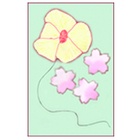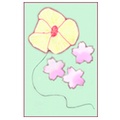I recently had a conversation with an old high school friend reminiscing what we did on the weekends growing up. She went to Catholic school on Saturdays to prepare for her first communion and confirmation while I went to Japanese school. Since one of the aims of this website is to preserve and share the experiences of Nikkei from all over the world, I thought I would take the month of March to talk about my “Nikkei” experience attending Japanese school every Saturday for eight years, between the ages of 7 and 15. It was indeed an adventure. In part one of this series, I talk about my very first year in Japanese school and the surprises that came with it. --Victoria Kraus
My first year of Japanese school was fun. I looked forward to it every week. I was seven years old, had just started the second grade, and loved using my Hello Kitty pencil case. My mom would drop me off on her way to work every Saturday morning and I would excitedly trot to class.
With the expectation that my classmates would all be speaking Japanese, I remember being surprised that no one in my class did. And yet, probably because I was seven, I was confused why all of my Japanese-looking classmates who used their Japanese names in class couldn’t or wouldn’t speak a word of it. This was my first vivid and hands-on experience I had distinguishing Japanese and Japanese American. I also learned all of my hiragana , katakana and easy kanji that year.
Until then, I had only known being Japanese as one type of thing. That is, I thought all people of Japanese descent living in the U.S. had parents from Japan, spoke fluent Japanese, and took their shoes off at the front door of their home. Growing up, I had a lot of Japanese American friends whose parents were Japanese from Japan. My mom was friends with their moms so we often spent time together going to each other’s homes. Our moms would speak to us in Japanese, telling us to be careful while we played in the front yard, and to wash our hands and gargle our mouths before we ate lunch. We, the kids, would always respond with an elongated “Hai!” that implied we understood and that we were busy enjoying our playtime outside.
It took me starting Japanese school to realize that Japanese Americans weren’t all second-generation sons and daughters of Japanese immigrants. A lot of my classmates were sent by their parents, who were also American (or Japanese American), to learn about Japanese culture simply because Japan was a part of their ethnic heritage. I remember some of my classmates telling me that they couldn’t remember anything they learned at Japanese school because they didn’t speak Japanese at home. Several of my classmates were there because they were in the same basketball league (for Japanese Americans). They usually had practice after school at the Japanese community center where our classes were held. And some were there because they loved Japanese manga or anime art and wanted to learn how to read the comics.
It’s interesting, now that I look back, to see the impact one generation displaced can have on the culture and traditions of a family. Most third-generation and on Japanese American families are more American than they are Japanese. I would even say that third-generation and on Japanese American families are not Japanese but completely American. (Calling people of Japanese ancestry “Japanese American” is still ambiguous if the generations aren’t distinguished.)
Fortunately, my elementary school ignorance has dissipated into what I call “twenty-something year-old ignorance.” Call it the Socrates effect. I know that I don’t know. And there’s a lot of it.
© 2007 Victoria Kraus




